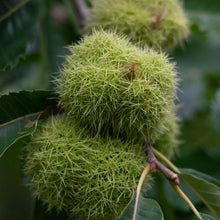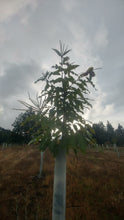|
Mature height x width: |
approx 30' x 30' |
|
Recommended initial spacing: |
5-10' in rows 15-30' apart |
|
Recommended final spacing: |
approx 30' apart |
| Hardy to: | approx -20 to -25°C (-10 to -5°F) |
|
Preferred soil: |
well-drained, slightly acidic, sandy loam |
|
Good for: |
marginal or fertile land, productive / low-maintenance crop |
|
Uses: |
grain substitute, desserts, main dishes |
Chestnuts were once a crucial staple crop in many parts of North America, Europe, and Asia, and they are enjoying a resurgence. Nuts can be roasted, boiled, or dried and milled into a flour. Chestnut trees are low-maintenance, productive, and tolerant of drought and sandy/rocky soils. Spiky shells deter squirrels from getting to nuts before you do.
This is a seedling from an orchard growing primarily grafted cultivars of European/Japanese crosses, with some pure European trees. That means the genetics of these trees are most likely a mix of European (Castanea sativa) and Japanese chestnut (Castanea crenata) (ExJ). We roasted and ate the nuts that we didn't plant, and they were delicious and easy to peel!
Planting: Chestnuts prefer well-drained, slightly acidic, sandy loam soil. They are intolerant of clay or wet soils. They are wind-pollinated so they require at least two to make nuts. Planting several in the same area helps to ensure adequate pollination. Requires watering for the first few years while they're getting established. Best planted when dormant (Nov-Mar) but can be planted later in spring.
Why seedlings? Growing seedlings from orchard cultivars helps maintain diversity (each seed is a new variety) while drawing on some of the best genetics for chestnuts in our bioregion. In other words, by planting and growing out these trees, you are participating in the breeding new, regionally-adapted chestnut varieties! The parents of these seedlings were selected for good production, large nuts, sweetness, precocity (producing nuts early in life), minimal cracking, and minimal pellicle intrusion (easy peeling). This means they are excellent stock for breeding new varieties of high-quality chestnuts. We recommend planting several of these trees closer together and selecting your final tree once they've produced their first nuts (3-5 years) so that you can select the most productive trees with the highest-quality nuts. Recommended final spacing is ~25' between the centre of each tree.
Why bare root? "Bare root" means that the tree has been grown in the ground (rather than in a pot). In general, bare root trees tend to have larger root systems because their roots aren't constricted by the edges of the pot. Because we don't need to use pots or potting soil, we can sell them more cheaply than potted trees. Bareroot trees should be planted when they are dormant (Nov - Mar in the Pacific Northwest; Nov - Apr in colder climates).





